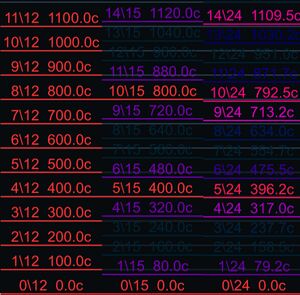User:Astaryuu/15edo Notes: Difference between revisions
m formatting |
|||
| Line 3: | Line 3: | ||
This page essentially serves as a harmonization of the other 15edo guides on the wiki, but with plenty of my own details. First, though, a note on what I mean by temperaments related to 15edo. | This page essentially serves as a harmonization of the other 15edo guides on the wiki, but with plenty of my own details. First, though, a note on what I mean by temperaments related to 15edo. | ||
=15edo-like temperaments= | ==15edo-like temperaments== | ||
As established by other wiki members, the [[valentine]] temperament and [[24edt]] are alternatives to 15edo. In my experience, using either is a suitable alternative to 15edo, depending on your purposes. | As established by other wiki members, the [[valentine]] temperament and [[24edt]] are alternatives to 15edo. In my experience, using either is a suitable alternative to 15edo, depending on your purposes. | ||
| Line 13: | Line 13: | ||
24 equal divisions of the [[3/1|tritave]] (an octave plus a perfect fifth) gets you an even closer approximation of both valentine and 12edo than 15edo does. Its octave equivalent, 15\24edt, is slightly flat of [[2/1]]. I've seen people comment that 24edt sounds better than 15edo, and the fact that 24edt tones better approximate 12edo is probably why. I personally like to use a variation on 24edt that cuts off at the octave, forcing it to be octave-equivalent rather than tritave-equivalent. At this point it's effectively 15edo tuned a little flat, but that's fine by me. | 24 equal divisions of the [[3/1|tritave]] (an octave plus a perfect fifth) gets you an even closer approximation of both valentine and 12edo than 15edo does. Its octave equivalent, 15\24edt, is slightly flat of [[2/1]]. I've seen people comment that 24edt sounds better than 15edo, and the fact that 24edt tones better approximate 12edo is probably why. I personally like to use a variation on 24edt that cuts off at the octave, forcing it to be octave-equivalent rather than tritave-equivalent. At this point it's effectively 15edo tuned a little flat, but that's fine by me. | ||
=Notes= | ==Notes== | ||
* On Notation (you're here!) | * On Notation (you're here!) | ||
* [[/Scales and modes]] | * [[/Scales and modes]] | ||
Latest revision as of 22:57, 11 July 2025
I've been tooling around with 15edo (and related temperaments like valentine and 24edt). Here are my notes on the subject.
This page essentially serves as a harmonization of the other 15edo guides on the wiki, but with plenty of my own details. First, though, a note on what I mean by temperaments related to 15edo.
15edo-like temperaments
As established by other wiki members, the valentine temperament and 24edt are alternatives to 15edo. In my experience, using either is a suitable alternative to 15edo, depending on your purposes.
Valentine
Valentine is a scale which uses 21/20 or a similar-sized semitone as its generator. It is best understood as 15edo with a compressed octave at scale degree 15. It misses the octave by less than a diesis, so many won't be able to tell you aren't using a complete octave. Still, the rational pitches of 15edo make it easier to program, as it does not miss the octave.
24edt

24 equal divisions of the tritave (an octave plus a perfect fifth) gets you an even closer approximation of both valentine and 12edo than 15edo does. Its octave equivalent, 15\24edt, is slightly flat of 2/1. I've seen people comment that 24edt sounds better than 15edo, and the fact that 24edt tones better approximate 12edo is probably why. I personally like to use a variation on 24edt that cuts off at the octave, forcing it to be octave-equivalent rather than tritave-equivalent. At this point it's effectively 15edo tuned a little flat, but that's fine by me.
Notes
- On Notation (you're here!)
- /Scales and modes
- /Notes and chords
On notation
Honestly, I'm too 12edo-pilled to consider sharps and flats not being the same to not break my brain, which is what the traditional spelling implies. So, here is my new notation, based on porcupine[8]:
| Degree | Astaryuu notation |
|---|---|
| 0 | α / θ# |
| 1 | α# / βb |
| 2 | β |
| 3 | β# / γb |
| 4 | γ |
| 5 | γ# / δb |
| 6 | δ |
| 7 | δ# / εb |
| 8 | ε |
| 9 | ε# / ζb |
| 10 | ζ |
| 11 | ζ# / ηb |
| 12 | η |
| 13 | η# / θb |
| 14 | θ |
This basically follows the Greek letter notation, but I find it really dumb that not only does the official one use accidentals that aren't the official sharp and flat letters, but more importantly, it also uses Greek letters that sound like the first eight Latin letters, rather than the actual first eight Greek letters.